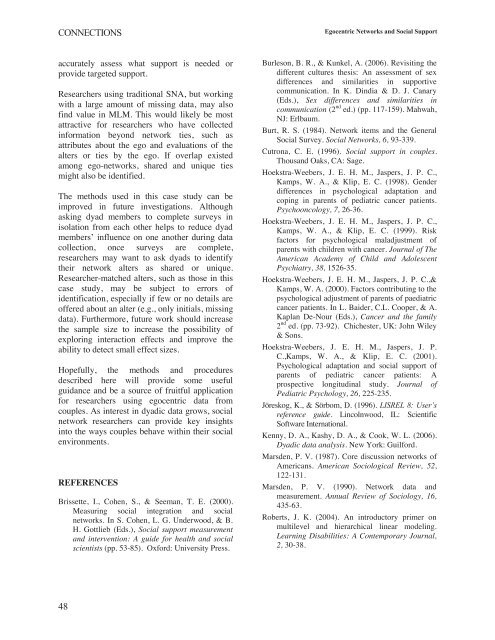CONNECTIONS - INSNA
CONNECTIONS - INSNA
CONNECTIONS - INSNA
You also want an ePaper? Increase the reach of your titles
YUMPU automatically turns print PDFs into web optimized ePapers that Google loves.
<strong>CONNECTIONS</strong><br />
Egocentric Networks and Social Support<br />
accurately assess what support is needed or<br />
provide targeted support.<br />
Researchers using traditional SNA, but working<br />
with a large amount of missing data, may also<br />
find value in MLM. This would likely be most<br />
attractive for researchers who have collected<br />
information beyond network ties, such as<br />
attributes about the ego and evaluations of the<br />
alters or ties by the ego. If overlap existed<br />
among ego-networks, shared and unique ties<br />
might also be identified.<br />
The methods used in this case study can be<br />
improved in future investigations. Although<br />
asking dyad members to complete surveys in<br />
isolation from each other helps to reduce dyad<br />
members’ influence on one another during data<br />
collection, once surveys are complete,<br />
researchers may want to ask dyads to identify<br />
their network alters as shared or unique.<br />
Researcher-matched alters, such as those in this<br />
case study, may be subject to errors of<br />
identification, especially if few or no details are<br />
offered about an alter (e.g., only initials, missing<br />
data). Furthermore, future work should increase<br />
the sample size to increase the possibility of<br />
exploring interaction effects and improve the<br />
ability to detect small effect sizes.<br />
Hopefully, the methods and procedures<br />
described here will provide some useful<br />
guidance and be a source of fruitful application<br />
for researchers using egocentric data from<br />
couples. As interest in dyadic data grows, social<br />
network researchers can provide key insights<br />
into the ways couples behave within their social<br />
environments.<br />
REFERENCES<br />
Brissette, I., Cohen, S., & Seeman, T. E. (2000).<br />
Measuring social integration and social<br />
networks. In S. Cohen, L. G. Underwood, & B.<br />
H. Gottlieb (Eds.), Social support measurement<br />
and intervention: A guide for health and social<br />
scientists (pp. 53-85). Oxford: University Press.<br />
Burleson, B. R., & Kunkel, A. (2006). Revisiting the<br />
different cultures thesis: An assessment of sex<br />
differences and similarities in supportive<br />
communication. In K. Dindia & D. J. Canary<br />
(Eds.), Sex differences and similarities in<br />
communication (2 nd ed.) (pp. 117-159). Mahwah,<br />
NJ: Erlbaum.<br />
Burt, R. S. (1984). Network items and the General<br />
Social Survey. Social Networks, 6, 93-339.<br />
Cutrona, C. E. (1996). Social support in couples.<br />
Thousand Oaks, CA: Sage.<br />
Hoekstra-Weebers, J. E. H. M., Jaspers, J. P. C.,<br />
Kamps, W. A., & Klip, E. C. (1998). Gender<br />
differences in psychological adaptation and<br />
coping in parents of pediatric cancer patients.<br />
Psychooncology, 7, 26-36.<br />
Hoekstra-Weebers, J. E. H. M., Jaspers, J. P. C.,<br />
Kamps, W. A., & Klip, E. C. (1999). Risk<br />
factors for psychological maladjustment of<br />
parents with children with cancer. Journal of The<br />
American Academy of Child and Adolescent<br />
Psychiatry, 38, 1526-35.<br />
Hoekstra-Weebers, J. E. H. M., Jaspers, J. P. C.,&<br />
Kamps, W. A. (2000). Factors contributing to the<br />
psychological adjustment of parents of paediatric<br />
cancer patients. In L. Baider, C.L. Cooper, & A.<br />
Kaplan De-Nour (Eds.), Cancer and the family<br />
2 nd ed. (pp. 73-92). Chichester, UK: John Wiley<br />
& Sons.<br />
Hoekstra-Weebers, J. E. H. M., Jaspers, J. P.<br />
C.,Kamps, W. A., & Klip, E. C. (2001).<br />
Psychological adaptation and social support of<br />
parents of pediatric cancer patients: A<br />
prospective longitudinal study. Journal of<br />
Pediatric Psychology, 26, 225-235.<br />
Jöreskog, K., & Sörbom, D. (1996). LISREL 8: User’s<br />
reference guide. Lincolnwood, IL: Scientific<br />
Software International.<br />
Kenny, D. A., Kashy, D. A., & Cook, W. L. (2006).<br />
Dyadic data analysis. New York: Guilford.<br />
Marsden, P. V. (1987). Core discussion networks of<br />
Americans. American Sociological Review, 52,<br />
122-131.<br />
Marsden, P. V. (1990). Network data and<br />
measurement. Annual Review of Sociology, 16,<br />
435-63.<br />
Roberts, J. K. (2004). An introductory primer on<br />
multilevel and hierarchical linear modeling.<br />
Learning Disabilities: A Contemporary Journal,<br />
2, 30-38.<br />
48
















